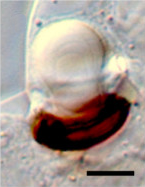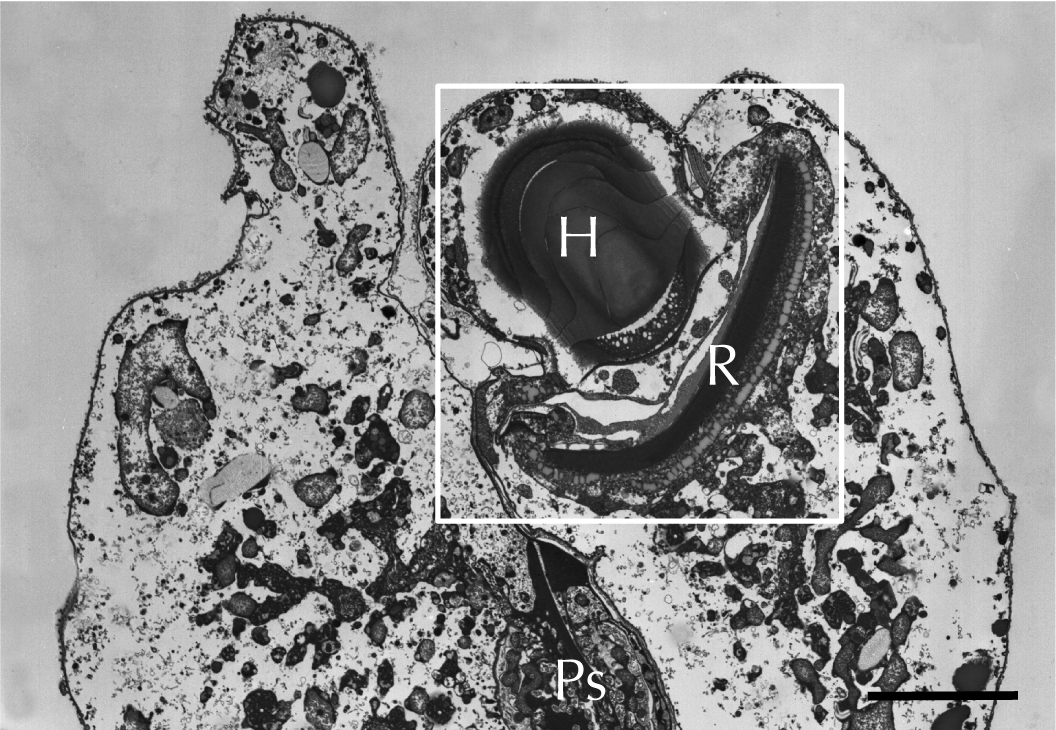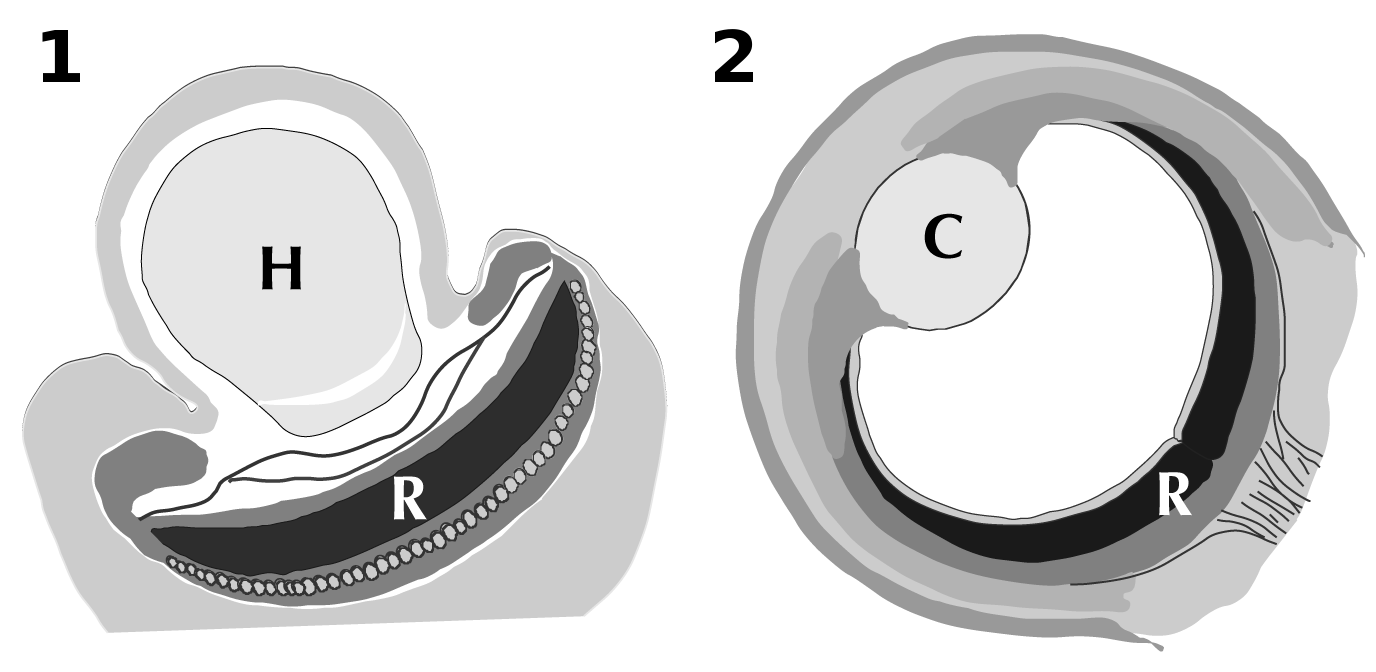Ocelloid on:
[Wikipedia]
[Google]
[Amazon]
 An ocelloid is a subcellular structure found in the
An ocelloid is a subcellular structure found in the

 Ocelloids contain subcomponents analogous to eye structures including the
Ocelloids contain subcomponents analogous to eye structures including the
 Due to the strong structural resemblance between the ocelloid and metazoan eyes, it has long been speculated that the ocelloid functions as a photoreceptor; however, this is difficult to determine experimentally because warnowiids cannot be cultured in the laboratory, and isolates from natural habitats degrade quickly. It has been shown that the morphology of the ocelloid changes in response to environmental illumination, that the ocelloid structure can be disrupted by exposure to extremely bright light, and that it contains proteins with sequence similarity to known light-sensitive proteins. It has been speculated that the ocelloid aids in detecting
Due to the strong structural resemblance between the ocelloid and metazoan eyes, it has long been speculated that the ocelloid functions as a photoreceptor; however, this is difficult to determine experimentally because warnowiids cannot be cultured in the laboratory, and isolates from natural habitats degrade quickly. It has been shown that the morphology of the ocelloid changes in response to environmental illumination, that the ocelloid structure can be disrupted by exposure to extremely bright light, and that it contains proteins with sequence similarity to known light-sensitive proteins. It has been speculated that the ocelloid aids in detecting
 An ocelloid is a subcellular structure found in the
An ocelloid is a subcellular structure found in the family
Family (from la, familia) is a group of people related either by consanguinity (by recognized birth) or affinity (by marriage or other relationship). The purpose of the family is to maintain the well-being of its members and of society. Idea ...
Warnowiaceae
The Warnowiaceae are a family of athecate dinoflagellates (a diverse group of unicellular eukaryotes). Members of the family are known as warnowiids. The family is best known for a light-sensitive subcellular structure known as the ocelloid, a hi ...
(warnowiids), which are members of a group of unicellular organism
A unicellular organism, also known as a single-celled organism, is an organism that consists of a single cell, unlike a multicellular organism that consists of multiple cells. Organisms fall into two general categories: prokaryotic organisms a ...
s known as dinoflagellate
The dinoflagellates ( Greek δῖνος ''dinos'' "whirling" and Latin ''flagellum'' "whip, scourge") are a monophyletic group of single-celled eukaryotes constituting the phylum Dinoflagellata and are usually considered algae. Dinoflagellates are ...
s. The ocelloid is analogous in structure and function to the eyes of multicellular
A multicellular organism is an organism that consists of more than one cell, in contrast to unicellular organism.
All species of animals, land plants and most fungi are multicellular, as are many algae, whereas a few organisms are partially ...
organisms, which focus, process and detect light. The ocelloid is much more complex than the eyespot, a light-sensitive structure also found in unicellular organisms, and is in fact one of the most complex known subcellular structures. It has been described as a striking example of convergent evolution
Convergent evolution is the independent evolution of similar features in species of different periods or epochs in time. Convergent evolution creates analogous structures that have similar form or function but were not present in the last com ...
.
History
The ocelloid was originally described in 1884. Early descriptions were met with skepticism and hypothesized to represent the eye of a multicellular organism coincidentally engulfed by a single-celled organism. The possibility that it had an evolutionary relationship toplastid
The plastid (Greek: πλαστός; plastós: formed, molded – plural plastids) is a membrane-bound organelle found in the cells of plants, algae, and some other eukaryotic organisms. They are considered to be intracellular endosymbiotic cyan ...
s had been considered at least since the 1970s, although until the 2010s direct evidence was scarce.
Structure

 Ocelloids contain subcomponents analogous to eye structures including the
Ocelloids contain subcomponents analogous to eye structures including the lens
A lens is a transmissive optical device which focuses or disperses a light beam by means of refraction. A simple lens consists of a single piece of transparent material, while a compound lens consists of several simple lenses (''elements ...
, cornea
The cornea is the transparent front part of the eye that covers the iris, pupil, and anterior chamber. Along with the anterior chamber and lens, the cornea refracts light, accounting for approximately two-thirds of the eye's total optical ...
, iris, and retina
The retina (from la, rete "net") is the innermost, light-sensitive layer of tissue of the eye of most vertebrates and some molluscs. The optics of the eye create a focused two-dimensional image of the visual world on the retina, which the ...
. It can be divided into two substructures, the translucent, roundish ''hyalosome'' and the heavily pigment
A pigment is a colored material that is completely or nearly insoluble in water. In contrast, dyes are typically soluble, at least at some stage in their use. Generally dyes are often organic compounds whereas pigments are often inorganic compou ...
ed ''melanosome'', also known as the retinal body or pigment cup. The hyalosome serves as the refractive lens
A lens is a transmissive optical device which focuses or disperses a light beam by means of refraction. A simple lens consists of a single piece of transparent material, while a compound lens consists of several simple lenses (''elements ...
of the ocelloid; it is surrounded by a layer of mitochondria
A mitochondrion (; ) is an organelle found in the cells of most Eukaryotes, such as animals, plants and fungi. Mitochondria have a double membrane structure and use aerobic respiration to generate adenosine triphosphate (ATP), which is used ...
serving as the cornea and has constrictive rings analogous to the iris. The retinal body has internal structure reminiscent of thylakoid
Thylakoids are membrane-bound compartments inside chloroplasts and cyanobacteria. They are the site of the light-dependent reactions of photosynthesis. Thylakoids consist of a thylakoid membrane surrounding a thylakoid lumen. Chloroplast thyl ...
membranes in chloroplast
A chloroplast () is a type of membrane-bound organelle known as a plastid that conducts photosynthesis mostly in plant and algal cells. The photosynthetic pigment chlorophyll captures the energy from sunlight, converts it, and stores it i ...
s and contains proteins related to bacteriorhodopsin
Bacteriorhodopsin is a protein used by Archaea, most notably by haloarchaea, a class of the Euryarchaeota. It acts as a proton pump; that is, it captures light energy and uses it to move protons across the membrane out of the cell. The resulting ...
, a light-sensitive protein found in some archaea
Archaea ( ; singular archaeon ) is a domain of single-celled organisms. These microorganisms lack cell nuclei and are therefore prokaryotes. Archaea were initially classified as bacteria, receiving the name archaebacteria (in the Archaeba ...
.
Using single-cell genomics
Genomics is an interdisciplinary field of biology focusing on the structure, function, evolution, mapping, and editing of genomes. A genome is an organism's complete set of DNA, including all of its genes as well as its hierarchical, three-dim ...
and electron microscopy
An electron microscope is a microscope that uses a beam of accelerated electrons as a source of illumination. As the wavelength of an electron can be up to 100,000 times shorter than that of visible light photons, electron microscopes have a hi ...
techniques, the ocelloid has been shown to consist of multiple membrane-bound organelle
In cell biology, an organelle is a specialized subunit, usually within a cell, that has a specific function. The name ''organelle'' comes from the idea that these structures are parts of cells, as organs are to the body, hence ''organelle,'' th ...
s with distinct endosymbiotic
An ''endosymbiont'' or ''endobiont'' is any organism that lives within the body or cells of another organism most often, though not always, in a mutualistic relationship.
(The term endosymbiosis is from the Greek: ἔνδον ''endon'' "within ...
origins deriving from multiple lineages of peridinin-containing plastid
The plastid (Greek: πλαστός; plastós: formed, molded – plural plastids) is a membrane-bound organelle found in the cells of plants, algae, and some other eukaryotic organisms. They are considered to be intracellular endosymbiotic cyan ...
s. This discovery received widespread attention in popular science
''Popular Science'' (also known as ''PopSci'') is an American digital magazine carrying popular science content, which refers to articles for the general reader on science and technology subjects. ''Popular Science'' has won over 58 awards, incl ...
media after it was reported in 2015.
Function
 Due to the strong structural resemblance between the ocelloid and metazoan eyes, it has long been speculated that the ocelloid functions as a photoreceptor; however, this is difficult to determine experimentally because warnowiids cannot be cultured in the laboratory, and isolates from natural habitats degrade quickly. It has been shown that the morphology of the ocelloid changes in response to environmental illumination, that the ocelloid structure can be disrupted by exposure to extremely bright light, and that it contains proteins with sequence similarity to known light-sensitive proteins. It has been speculated that the ocelloid aids in detecting
Due to the strong structural resemblance between the ocelloid and metazoan eyes, it has long been speculated that the ocelloid functions as a photoreceptor; however, this is difficult to determine experimentally because warnowiids cannot be cultured in the laboratory, and isolates from natural habitats degrade quickly. It has been shown that the morphology of the ocelloid changes in response to environmental illumination, that the ocelloid structure can be disrupted by exposure to extremely bright light, and that it contains proteins with sequence similarity to known light-sensitive proteins. It has been speculated that the ocelloid aids in detecting prey
Predation is a biological interaction where one organism, the predator, kills and eats another organism, its prey. It is one of a family of common feeding behaviours that includes parasitism and micropredation (which usually do not kill ...
, possibly other dinoflagellates.
Evolution
Ocelloids are considered asynapomorphic
In phylogenetics, an apomorphy (or derived trait) is a novel character or character state that has evolved from its ancestral form (or plesiomorphy). A synapomorphy is an apomorphy shared by two or more taxa and is therefore hypothesized to have ...
character for the warnowiids - that is, they are present in all warnowiids and presumed present in the common ancestor, but are not present in the closest extant relatives, the polykrikoid dinoflagellates. These two groups share other unusually complex subcellular structures such as nematocyst
A cnidocyte (also known as a cnidoblast or nematocyte) is an explosive cell containing one large secretory organelle called a cnidocyst (also known as a cnida () or nematocyst) that can deliver a sting to other organisms. The presence of this ce ...
s and piston
A piston is a component of reciprocating engines, reciprocating pumps, gas compressors, hydraulic cylinders and pneumatic cylinders, among other similar mechanisms. It is the moving component that is contained by a cylinder and is made gas-t ...
s.
The molecular evidence is compelling that ocelloids are composed of multiple endosymbiont
An ''endosymbiont'' or ''endobiont'' is any organism that lives within the body or cells of another organism most often, though not always, in a mutualistic relationship.
(The term endosymbiosis is from the Greek: ἔνδον ''endon'' "within ...
s: mitochondria
A mitochondrion (; ) is an organelle found in the cells of most Eukaryotes, such as animals, plants and fungi. Mitochondria have a double membrane structure and use aerobic respiration to generate adenosine triphosphate (ATP), which is used ...
and at least one type of plastid
The plastid (Greek: πλαστός; plastós: formed, molded – plural plastids) is a membrane-bound organelle found in the cells of plants, algae, and some other eukaryotic organisms. They are considered to be intracellular endosymbiotic cyan ...
. Ocelloids are likely to be homologous to much less complex plastid-containing eyespots found in other, distantly related dinoflagellates.
See also
* Evolution of the eye *Eyespot apparatus
The eyespot apparatus (or '' stigma'') is a photoreceptive organelle found in the flagellate or (motile) cells of green algae and other unicellular photosynthetic organisms such as euglenids. It allows the cells to sense light direction and int ...
References
External links
* {{youtube, v6voldJVGC4, ''Erythropsidinium'' ocelloid dinoflagellates Organelles Sensory receptors